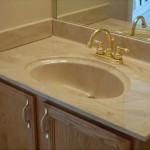How to Clean a Plug-in Bathroom Sink
Bathroom sinks are prone to accumulating grime, soap scum, and hair, especially in the plug-in area. Regular cleaning of this area is essential for maintaining a hygienic and aesthetically pleasing bathroom. This article provides a comprehensive guide on how to effectively clean a plug-in bathroom sink.
Gather Your Supplies
Before starting the cleaning process, gather the necessary supplies:
- A cleaning solution: White vinegar, baking soda, or a commercial bathroom cleaner.
- A soft-bristled brush or a toothbrush.
- A cloth or sponge.
- A bowl or container.
- Warm water.
- Rubber gloves (optional).
Step-by-Step Cleaning Process
Follow these steps for a thorough cleaning of your plug-in bathroom sink:
- Remove the Plug: Unscrew or lift the plug from the sink drain. This allows for easier access to the surrounding area.
- Clean the Plug: Use a toothbrush or a soft-bristled brush to scrub the plug, removing any accumulated grime, hair, or debris. If necessary, soak the plug in a bowl of warm water and cleaning solution for a few minutes to loosen stubborn dirt. Rinse the plug thoroughly with water and set it aside to dry.
- Clean the Drain: Pour a solution of white vinegar or a bathroom cleaner down the drain. Let it sit for a few minutes to dissolve any buildup. Use a brush, cleaning tool, or a long, thin object to gently scrub the drain area. Rinse the drain thoroughly with water, ensuring all cleaning solution and debris are removed.
- Clean the Sink Basin: Spray or pour a cleaning solution onto the sink basin, focusing on the area around the drain and any visible grime. Use a soft-bristled brush or a sponge to scrub the area. Rinse the basin thoroughly with water, removing any remaining cleaning solution and debris.
- Clean the Overflow Drain: Using a toothbrush or a soft-bristled brush, gently scrub the overflow drain area to remove any accumulated debris. Rinse the overflow drain thoroughly with water.
- Clean the Faucet: Use a damp cloth to wipe down the faucet, removing any water spots, soap scum, or fingerprints. If necessary, use a dedicated faucet cleaner for stubborn stains.
- Dry All Surfaces: Use a clean dry cloth to dry all surfaces, including the sink basin, faucet, and plug. This step is crucial for preventing water spots and potential bacteria growth.
- Reinstall the Plug: Reinstall the plug back into the sink drain, ensuring it is securely fastened.
Tips for Maintaining a Clean Plug-in Bathroom Sink
Implementing these tips can help maintain a clean and hygienic plug-in bathroom sink between deep cleaning sessions:
- Regularly Clean the Plug: After each use, wipe down the plug with a damp cloth to prevent the accumulation of hair and debris. This simple step can significantly reduce the need for deep cleaning.
- Avoid Pouring Grease or Oil Down the Drain: These substances can solidify in the drain, causing clogs and unpleasant odors. Dispose of grease and oil responsibly.
- Use a Drain Stopper: A drain stopper can prevent hair and debris from entering the drain, making cleaning easier. Choose a stopper made of durable material and ensure it is properly installed.
- Consider Using a Drain Cleaning Solution Regularly: Using a drain cleaning solution periodically can help prevent clogs and maintain a clean and odor-free drain.
By following these steps and tips, you can ensure your plug-in bathroom sink remains clean, hygienic, and free of obstructions.

How To Clean A Clogged Sink Remove Stopper

How To Clear A Clogged Drain Reviews By Wirecutter

How To Remove A Sink Stopper The Home Depot

3 Ways To Clean A Bathroom Sink Drain Wikihow

3 Ways To Clean A Bathroom Sink Drain Wikihow
How To Get A Bathroom Sink Plug Removed When It Won T Un Quora

Cleaning S Remove Hair From Your Plug In 6 Simple Steps Express Co

Mrs Hinch S Secret Spoon Shows How Filthy Plug Holes Really Are And People Disgusted By The Results Sun

How To Fix Pop Up Drain Waste Plug

How To Fix Or Maintain Your Sink S Pop Up Mechanism







